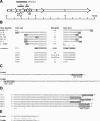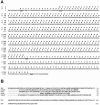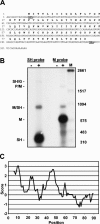Characterization of the Tupaia rhabdovirus genome reveals a long open reading frame overlapping with P and a novel gene encoding a small hydrophobic protein
- PMID: 15890917
- PMCID: PMC1112159
- DOI: 10.1128/JVI.79.11.6781-6790.2005
Characterization of the Tupaia rhabdovirus genome reveals a long open reading frame overlapping with P and a novel gene encoding a small hydrophobic protein
Abstract
Rhabdoviruses are negative-stranded RNA viruses of the order Mononegavirales and have been isolated from vertebrates, insects, and plants. Members of the genus Lyssavirus cause the invariably fatal disease rabies, and a member of the genus Vesiculovirus, Chandipura virus, has recently been associated with acute encephalitis in children. We present here the complete genome sequence and transcription map of a rhabdovirus isolated from cultivated cells of hepatocellular carcinoma tissue from a moribund tree shrew. The negative-strand genome of tupaia rhabdovirus is composed of 11,440 nucleotides and encodes six genes that are separated by one or two intergenic nucleotides. In addition to the typical rhabdovirus genes in the order N-P-M-G-L, a gene encoding a small hydrophobic putative type I transmembrane protein of approximately 11 kDa was identified between the M and G genes, and the corresponding transcript was detected in infected cells. Similar to some Vesiculoviruses and many Paramyxovirinae, the P gene has a second overlapping reading frame that can be accessed by ribosomal choice and encodes a protein of 26 kDa, predicted to be the largest C protein of these virus families. Phylogenetic analyses of the tupaia rhabdovirus N and L genes show that the virus is distantly related to the Vesiculoviruses, Ephemeroviruses, and the recently characterized Flanders virus and Oita virus and further extends the sequence territory occupied by animal rhabdoviruses.
Figures





References
-
- Barclay, A. J., and D. J. Paton. 2000. Hendra (equine morbillivirus). Vet. J. 160:169-176. - PubMed
-
- Bhatt, P. N., and F. M. Rodrigues. 1967. Chandipura: a new Arbovirus isolated in India from patients with febrile illness. Indian J. Med. Res. 55:1295-1305. - PubMed
-
- Bras, F., D. Teninges, and S. Dezelee. 1994. Sequences of the N and M genes of the sigma virus of Drosophila and evolutionary comparison. Virology 200:189-199. - PubMed
Publication types
MeSH terms
Substances
Associated data
- Actions
LinkOut - more resources
Full Text Sources

